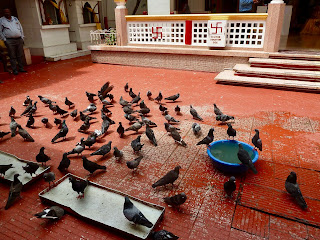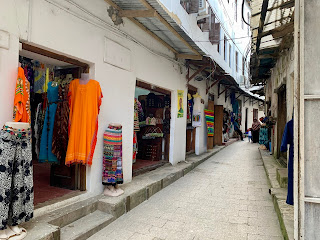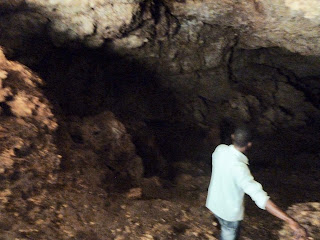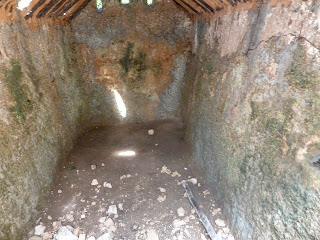13th - 16th Nov 2020
 |
| Kasuku, the fearless whistling parrot at Bottoms Up. |
As previously mentioned there is a diversity of cultures in Zanzibar; predominantly a mix of Arabic, African and Indian and all seem to rub along happily. The complicated history has involved Swahili people, Portuguese, Omani, German, Indian and British. Look it up if you are that interested and it takes up several volumes.
Left: More Hindu pigeons. The swastikas on the wall are a common Asian religious symbol for 'good fortune'. The word comes from the Sanskrit language but the symbol, turned 45º anti-clockwise, was hijacked by Mr Hitler's National Socialist German Workers' Party in the 1930s.
Wandering, mostly lost, around the narrow alleyways of Stone Town you pass lots of little shops (right). There are certainly no Waitrose, or even Lidl, equivalents. You would be forgiven for thinking that these are rather scruffy and downmarket but a surprising number, despite their humble fronts, conceal smart and elegant interiors.
Such as this clothes shop (left).
Left: Many skilfully carved wildlife pieces on display.
Right: Another mini-emporium selling beautifully made and colourful hand-crafted bags.
I may have mentioned that plastic bags are, very sensibly, banned in Tanzania. All goods bought are given to you in paper or fibre bags. Why can't we do that in UK? Just lots of words decrying them..."all mouth and no trousers", so to speak.
Right: One of the many 'Maasai' shops which sell elaborate bangles and beads and things to wear around your neck.
I now realise that I have been spelling Maasai wrong, but buggered if I am going back to correct. Maasai are renowned for 'jumping', cattle herding and speak their own language, 'Maa'.
There are little shops that sell just about everything you may need, but you have to know where to find them. I wanted some electric insulating tape. I relied on Ali (one of the hotel receptionists) to take me to one, which he did, on his scooter. I could never find it again by myself. It's that sort of place.
Actually I slightly exaggerate. I have belatedly discovered the magic of a phone navigation 'App' called 'maps.me'. A real saving grace around here and it doesn't rely on a phone or internet connection. I'm probably the last person in the world to discover it.
Left: I think this little shack might be over-stating its credentials. It advertises 'Georgio Armani of Zanzibar' over the door. Maybe not; I didn't go in and their prices were probably well beyond my reach.
I have noticed an increasing number of tourists around town. I expect more people are discovering the freedom this place offers from their countries' 'lockdowns' and social restrictions. There are many Russians and Eastern Europeans. I am told there are direct flights from Moscow and other Russian airports. I have also met up with some amusing Brit escapees amongst other nationalities.
Left: A little gaggle of Muslim schoolgirls. Sometimes there are swarms of them.
The slave trade here was 'officially' ended in 1873. But it wasn't. It went, literally, underground. The market in Stone Town was closed down. Slaves were then imported and held at other locations, undiscovered by the British or any other interfering nations.
One site was this cavern at Mangapwani.
Previously used by the villagers, it then housed slaves in extremely uncomfortable damp conditions. There is a tunnel, running almost a mile from the entrance to the beach, down which the slaves were brought in and out, to and from ships.
It was dark and dripping damp in there with a very rocky, slippery and uneven floor. A fresh water pool supplied their water. The tunnel to the beach was now partially closed off and no way would I have wished to scramble down it. A torch shone inside triggered a swarm of bats to escape to darker places. Up to 100 men, women and children "slaves' were kept in here at any one time.
Right: Daylight from the entrance flooding into the cave.
Left: One of the exits nearer to, but not at, the beach.
About 2 miles away was another covert site at which slaves were held.
Left: This time in semi-underground cells. There were concealed pathways down to the beach.



























No comments:
Post a Comment